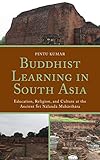Buddhist learning in South Asia : education, religion, and culture at the ancient Śrī Nālandā Mahāvihāra.
Material type: TextPublisher: Lanham : Lexington Books, 2018Description: 1 online resourceContent type:
TextPublisher: Lanham : Lexington Books, 2018Description: 1 online resourceContent type: - 9781498554930
- 1498554938
- 294.3444 23
- BQ4570.E34
- online - EBSCO
| Item type | Current library | Call number | URL | Status | Notes | Barcode | |
|---|---|---|---|---|---|---|---|
 eBook
eBook
|
Biblioteca "Angelicum" Pont. Univ. S.Tommaso d'Aquino Nuvola online | online - EBSCO (Browse shelf(Opens below)) | Online access | Not for loan (Accesso limitato) | Accesso per gli utenti autorizzati / Access for authorized users | (ebsco)1794495 |
Browsing Biblioteca "Angelicum" Pont. Univ. S.Tommaso d'Aquino shelves, Shelving location: Nuvola online Close shelf browser (Hides shelf browser)
Online resource; title from PDF title page (EBSCO, viewed April 24, 2018)
Includes bibliographical references and index.
Intro; Contents; Acknowledgments; One: Origin, Growth, and Decay of Śrī Nālandā Mahāvihāra; Two: Śrī Nālandā Mahāvihāra in Travelogues and Archaeology; Three: Pre-Nālandā/Brāhmaṇical Education: Gurukulas; Four: Śrī Nālandā Mahāvihāra: An Institution of Religious Learning; Five: Śrī Nālandā and Buddhist Learning; Six: Śrī Nālandā's Monastic Organization and Religion; Seven: Life, Ritual, and Influences; Conclusion; Bibliography; Index
This interdisciplinary study provides a broad analysis of Śrī Nālandā Mahāvihāra, the Buddhist learning center, during the first millennium AD. Drawing from history, archaeology, and religious studies, the author examines its role both as a religious and educational institution and investigates the impact of nationalist interpretations of the site.









